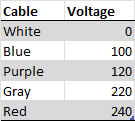Since the first post on my analog multimeter happened a few things.
I was thinking about the scale plate. If I order it as a PCB, why not to add some useful electronics to it. And I did. Adding a few LEDs will give a perfect backlight for the meter.
Also, I figured out, what to add to the back side. I've a few from this meter in the box with center zero configuration, so I added the same layout (with the LEDs) to the back side with center zero scale. Removed the "V" designator from the original design to add some versatility.
The back cover, with the mirror (3D printed insert + mirror foil) assembled:
Let there be light:
The assembled panel meter (no, I will not keep this scratchy plexi cover in the final instrument):
On the side, I started to work on the electronics. As it still far from ready, a few things are already settled. First of all the power supply voltages - Yes, you can tell it is too early, without the final design, but by my opinion, is a right time to try out some things.
What I already know about the analog section that I need a symmetrical, very low noise design, with the minimum achievable offset voltage - It is my assumption that the supply voltage is not really mater in a certain range, but the positive and the negative rail should match as much as possible.
So I "designed" an analog power supply. This first version is just to prove my concept, definitely not the final one. It will provide +-5V, roughly 1A. It is based on Walt Jung and Jan Didden's work called "SuperRegulator". Actually, I changed the reference to an MCP1502-25 from Microchip, changed the level shifting zener to LEDs (according to Walt Jung, it generate noise), and the negative side is not a separate regulator, but a tracking one. Also the Op Amps supply will be symmetric.
The design now is SMT except the power elements (two power transistors and two pre-regulators) also used a DIP socket for the Op Amp, to be able to try out different ones. My plan is OPA2180, but we will see, what is the best option.
I also designed the board for it:
Roughly a week ago I got a message from PCBWay marketing, that they recognize my work, and intend to sponsor my efforts with the PCB manufacturing.
This is an excellent news for me. This board is ordered from them. I eagerly waiting to arrive, and be able to review and also build this design. I'm looking forward to work with you guys.
I'm thinking about to enter with the part of this instrument.
Actually a circuit is "itching" in me for a while. This is a precision rectifier. Yes, you can tell, this is a well known, commonly used thing, but ...
Yes, that "but" is always there. I seen something as a patent entry from Microsoft (yes, this is funny, why Microsoft is trying to get a patent on an analog circuit), what, as it looks like not accepted.
This is what I feel a really good solution. I don't found drawbacks, but I'm really not qualified to judge this.
So, I started to design something based on that. Currently it is just a simulation, not using real components, it is just for functional proof.
The circuit:
It is based on an inverting and a non-inverting imput Op Amp (keeping constant input impedance, and creating inverted output also), a comparator, an analog switch and an output buffer.
Here is the produced waveform:
Don't forget, right know it is only theoretical, and low frequency. In the analog multimeter project I not even planning to use it for rectification, rather for automated polarity switching.
Next, I'll design the real circuit and PCB for not just test the functionality, but also the performance of it.
This is all for today. I'll continue (hopefully soon)
























